5.6: Résumé & Cover Letter
- Page ID
- 15108
Learning Objectives
- Determine the content, organization, format, and general strategies for résumés and cover letters.
- Demonstrate the content, organization, format, and general strategies for résumés and cover letters
Résumé
Résumés are flexible documents that can grow as you gain more education or more professional experience. A résumé is a summary of your educational background, employment experience, and skills. It is a way to communicate your qualifications for the desired position to an employer. Your résumé is your tool to market yourself and the key to getting an interview. Essentially, you are creating your résumé as a pitching, selling, and branding tool of yourself to potential employers.
There is no "best way" to write a résumé. However, there are some general guidelines, such as clarity, accuracy, and neatness, that should be followed. It is important to choose a résumé style and format that will work best for you and the job you are applying for. How do you decide what approach will be the best? Here are some questions you can ask yourself to help with the decision:
- What are the employer's needs in the position for which I am applying?
- What are my strengths for the job and how can I emphasize them?
- How can I format and organize the content of my résumé to show what I have to offer?
We will study three types of résumés: chronological, skills, and a combination of the two. Regardless of the format, employers have expectations for your résumé. They expect it to be clear, accurate, and up to date. This document represents you in your absence, and you want it to do the best job possible. You don’t want to be represented by spelling or grammatical errors as they may raise questions about your education and attention to detail. Someone reading your résumé with errors will only wonder what kind of work you might produce that will poorly reflect on their company. There is going to be enough competition that you don’t want to provide an easy excuse to dismiss your résumé at the start of the process. Do your best work the first time.
Components of a Résumé
Résumés have several basic elements that employers look for including your contact information, objective or goal, education and work experience, and so on. Each résumé format may organize the information in distinct ways based on the overall design strategy, but all information should be clear, concise, and accurate.
Contact Information
This section is often located at the top of the document. The first element of the contact information is your name. You should use your full, legal name even if you go by your middle name or use a nickname. There will plenty of time later to clarify what you prefer to be called, but all your application documents, including those that relate to payroll, your social security number, drug screenings, background checks, fingerprint records, transcripts, certificates or degrees, should feature your legal name. Other necessary information includes your address, phone number(s), and email address. If you maintain two addresses (e.g., a campus and a residential address), make it clear where you can be contacted by indicating the primary address. For business purposes, do not use an unprofessional email address like Imhot93@google.com or tutifruti@yahoo.com. Create a new email account if needed with an address suitable for professional use.
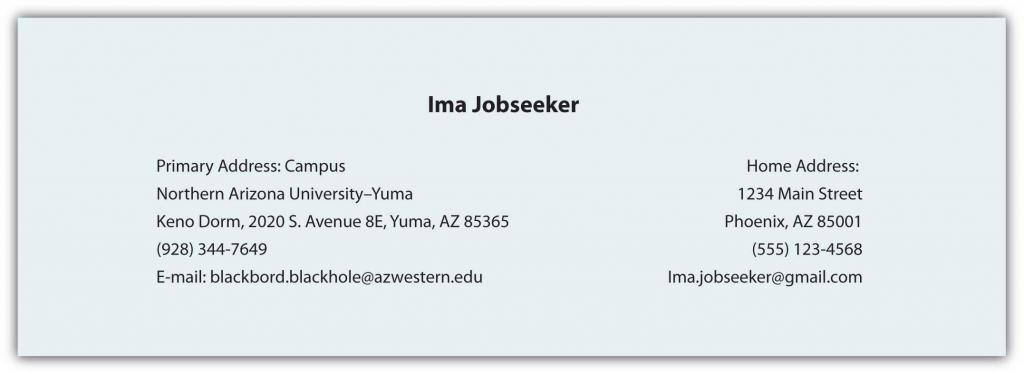
Objective
The objective is one part of your résumé that is relatively simple to customize for an individual application. Your objective should reflect the audience’s need to quickly understand how you will help the organization achieve its goals. Objectives are optional. Some people think objectives can be limiting. For example, Mary writes as her objective, "To receive the internship offered as the new event planner assistant." What about after she receives the internship? Does she not want to go further in the company? So, objectives could be limiting because there is no way to encompass everything you would like to do and accomplish within one objective.

Education
Education should be included immediately after your contact information unless you have had significant work experiences in the field for which you are applying. In that case, education should be placed later in the résumé. List your education in reverse chronological order with your most recent degree first. Include the name of the school, its location, the degree you achieved or are working to achieve, and the graduation date or expected graduation date. Your GPA should be included only if it is above average. If there is a difference between the GPA in your major courses and your overall GPA, you may want to list them separately to demonstrate your success in your chosen field. You may also want to highlight relevant coursework that directly relates to the position. You should avoid adding anything about high school unless it is particularly impressive.
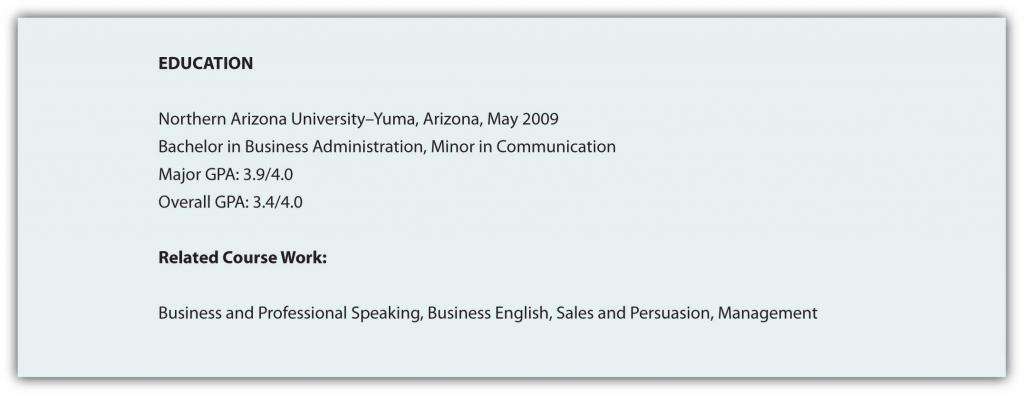
Work Experience
List in reverse chronological order your employment history. For each job, include the positions, company name, company location, dates of employment, duties and skills demonstrated or acquired. You may choose to use active, descriptive sentences or bulleted lists, but be consistent. Emphasize responsibilities that involved budgets, teamwork, supervision, and customer service when applying for positions in business and industry, but don’t let emphasis become exaggeration. This document represents you in your absence, and if the information is false, at a minimum you could lose your job.
When describing your work experience, use action verbs, not nouns. Use strong verbs to show what you did at that job and avoid lifeless, uninteresting verbs. Lastly, make sure the verbs are parallel.
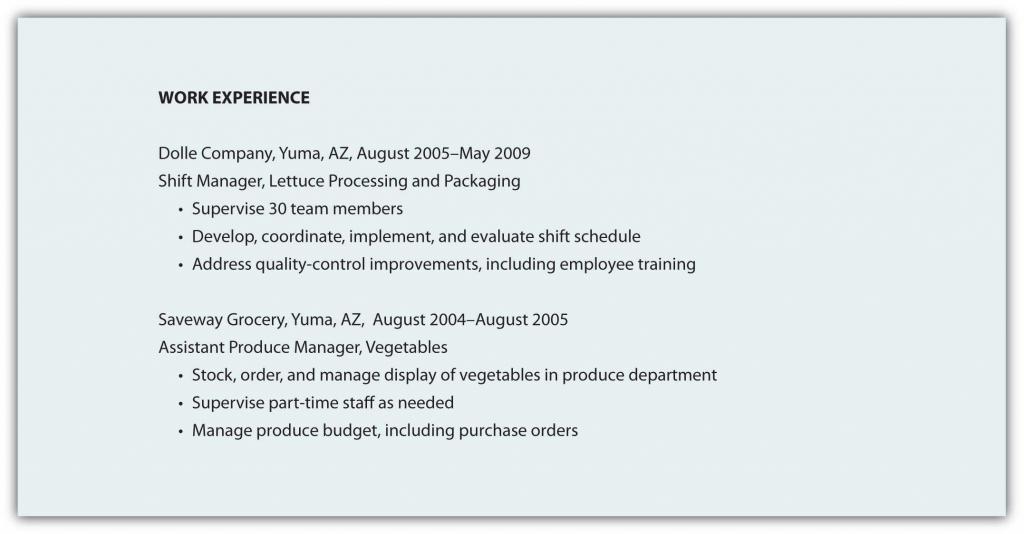
Achievements
Awards, recognitions, or other special circumstances should be included if they are outstanding and directly related to the job for which you are applying. Include the dates they were awarded and list them in reverse chronological order.
Volunteer Experience
Include information on present or former volunteering sites within your résumé. The information included should be the company name, location, and specific dates you volunteered. List these experiences in reverse chronological order.
Skills
Include any special skills that you have, such as being fluent in another language or being an expert in Microsoft applications. These skills can be what set you apart from the other applicants.
References
References are to be included at your own discretion. If you do list them on your résumé, it is common practice to list three. When choosing references, be sure to ask them if they are willing to be a reference before giving their information to a potential employer. If you choose not to include references on your résumé, you will need to include the statement "References available upon request" at the end of the résumé.
Types of Résumés
As noted above, there are three main types of résumés: chronological, skills, and a combination of the two. Each type emphasizes a different component of the résumé. Chronological résumés emphasize education and work experience, skills résumés emphasize skills and abilities, and combination résumés seek to find a balance between the two. When deciding what type of résumé to create, choose one that is common to your industry. Every industry uses different types of résumés according to what the industry standard is.
Chronological Résumé
A chronological résumé lists information in reverse chronological order. Your information is organized under headings such as “Education,” “Work Experience,” and “Activities.” Most college students will choose to list education first because students may have limited work experience. On a chronological résumé
- In the education section, the most recent educational degree (or a degree in progress) is listed first followed by any previous degrees. Include the type of the degree, the date of graduation, the name of the school, and the location of the school. You can also include any classes that pertain to the job you are applying for.
- In the work experience section, the most recent work experience is listed first followed by any prior work experience. Include the job title, dates of employment, and the place of employment, including its location. Skills gained from each job are listed under each job title, along with accomplishments and responsibilities.
Chronological résumés are useful for establishing a work history and for showcasing accomplishments made at each career position. Chronological résumés are the most common type of résumé and are a simple way to detail responsibilities held at different jobs.
This is an example of a chronological résumé.
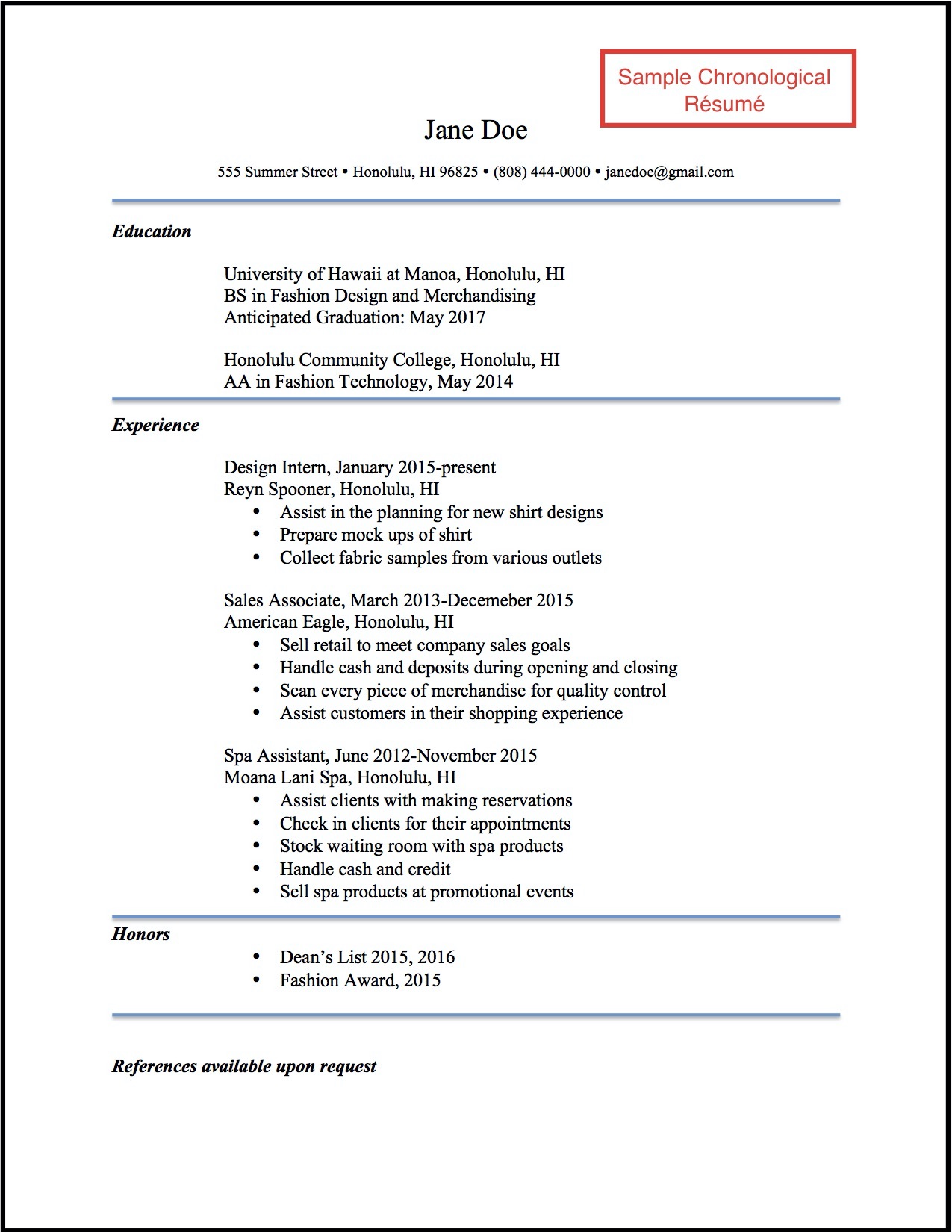
Figure \(\PageIndex{5}\): Sample Chronlogical Resume
Skills Résumé
A skills résumé organizes information around types of skills and abilities. Headings may include “Computer Skills,” “Foreign Languages,” and “Leadership Experience.” A skills résumé will list the skill and then explain when and how that particular skill was used. A skills résumé is useful for several reasons.
- Avoids repeating the same information under each job title
- Emphasizes skills and abilities (a college graduate’s work history may be from only part-time work, and a skills résumé will merely mention these positions)
- Deemphasizes gaps in an applicant's work history
Anytime attention should be focused away from work experience, a skills résumé is recommended.
This is an example of a skills résumé.

Figure \(\PageIndex{6}\): Sample Skills Resume
Combination Résumé
A combination résumé lists skills and abilities first but also lists accomplishments and responsibilities under specific job titles and experiences. A combination résumé allows an applicant to highlight specific skills that may be desired by the employer while also emphasizing job experience. Combination résumés are useful for applicants with an extensive job history in a highly specialized field. For example, applicants in computer programming may want to highlight their computer language skills before detailing their computer programming experience.
This is an example of a combination résumé.

Figure \(\PageIndex{7}\): Sample Combination Resume
Designing your Résumé
Your résumé is the first step in obtaining an interview and potentially getting hired. A major question you want to ask yourself when creating your résumé is "How do I want the employer to see me?" You can create a résumé that is uniquely yours and that will stand apart from others by illustrating your personality within your résumé.
Simplicity: Do not clutter the page with unnecessary information. Keep your headings short, informative, to-the-point, and clear of graphics. Résumés should be concise and easy to read to ensure that the potential employer can find the information they need quickly. Generally, people look at these for about 30 seconds, so you want them to have a solid idea of your qualifications in less time than that.
Length: You may be tempted to extend your résumé to more than one page, but don’t exceed that limit unless the additional page will feature specific, relevant information that represents several years of work that directly relates to the position. The person reading your résumé may be sifting through many applicants and will not spend time reading extra pages. Use the one-page format to put your best foot forward, remembering that you may never get a second chance to make a good first impression.
Consistency: Use the same formatting for similar sections on your résumé. Use line breaks, indents, and font variations to organize relevant information into sections. For example, you could use a different font for the headings. This will make your résumé more aesthetically pleasing. Make sure all headings are the same size and type (bold, italic, etc…).
Font: Use fonts that are easy to read. This is important for two reasons: 1) If you send an electronic version of your résumé as a Microsoft Word document, common font styles such as Arial or Times New Roman will likely transfer properly while less-common fonts may transfer improperly and be unreadable; 2) If you use a hard-to-read font, the reader may decide not to read the résumé if it is too challenging to read.
Verbs: When speaking of past tasks you performed at a previous job, verbs should be in the past tense form. If you are speaking of job tasks you currently perform, use the present tense. Use action verbs. Use a thesaurus as a resource in order to not repeat verbs.
Paper: If you are going to print your résumé, choose a fine grade paper. There are many paper options but using white or slightly off-white paper that is thicker than traditional printer paper is common practice. Avoid using colored paper to avoid sending the wrong impression to your reader. Remember, your résumé is the first glimpse into who you are.
Cover Letter
When you apply for a job using a printed résumé, it should be accompanied by a cover letter. This letter expands on some of what you mention in your résumé. Normally, this letter has at least four paragraphs: 1) an introduction that states the desired position; 2) education; 3) experience; and 4) conclusion. Since this letter is the first item an employer will see, it is vital that it be well designed and error free.
Functions of a cover letter
- Introduces you to a potential employer and explains what you can offer the employer.
- Shows your interest in a position.
- Describes how your education and experiences make you a prime candidate for the open position.
Components of a Cover letter
Cover Letters have four parts: an introduction, an education paragraph, an experience paragraph, and a conclusion.
Introduction: The introduction will
- State what job you are applying for and how you found out about the job opening
- Ask to be considered for the position
- Forecast the rest of the letter.
Education paragraph. For most students, this will come before the experience paragraph if they do not have much work experience. In this paragraph, highlight the educational experiences you have had that make you most qualified for the job. What parts of your education make you most qualified for the job? Write about your degree(s) and any courses, projects, or assignments related to the job you are applying for. This will show the employer why it would be to their advantage to hire you.
Experience paragraph. In this paragraph, you want to begin by writing about any job experience (paid or unpaid) that relates to the job you seek. Or, if you don’t have similar experience but you have had several jobs, you could write about your broad job experience and what skills you have learned that will help you in the job for which you are applying. In addition to highlighting specific skills, this will show that you know what’s involved with having and job and that you are more likely to have good work habits and a good work ethic.
Concluding Paragraph: The purpose of this paragraph is to encourage the employer to contact you for an interview. In this paragraph, you will
- Request an interview at the employer’s convenience
- Provide your contact information
- Refer to your enclosed résumé.
Ethics in Cover Letters
It is important to practice good ethics even in the early stages of applying for a job. Unethical representation of yourself is not only unprofessional but in some instances it is illegal. Be confident with the skills and experiences you already have and represent them honestly.
Some applicants believe that although lying in a cover letter is frowned upon, exaggeration is fine. However, employers may react to exaggeration in the same way as they do to lying. The skills and abilities you write about in a cover letter will be expected of you if you get the job. If you cannot perform as you stated, they can fire you. They will do this because it took time and money to hire you, and if they have to replace you right away, they will not be impressed.
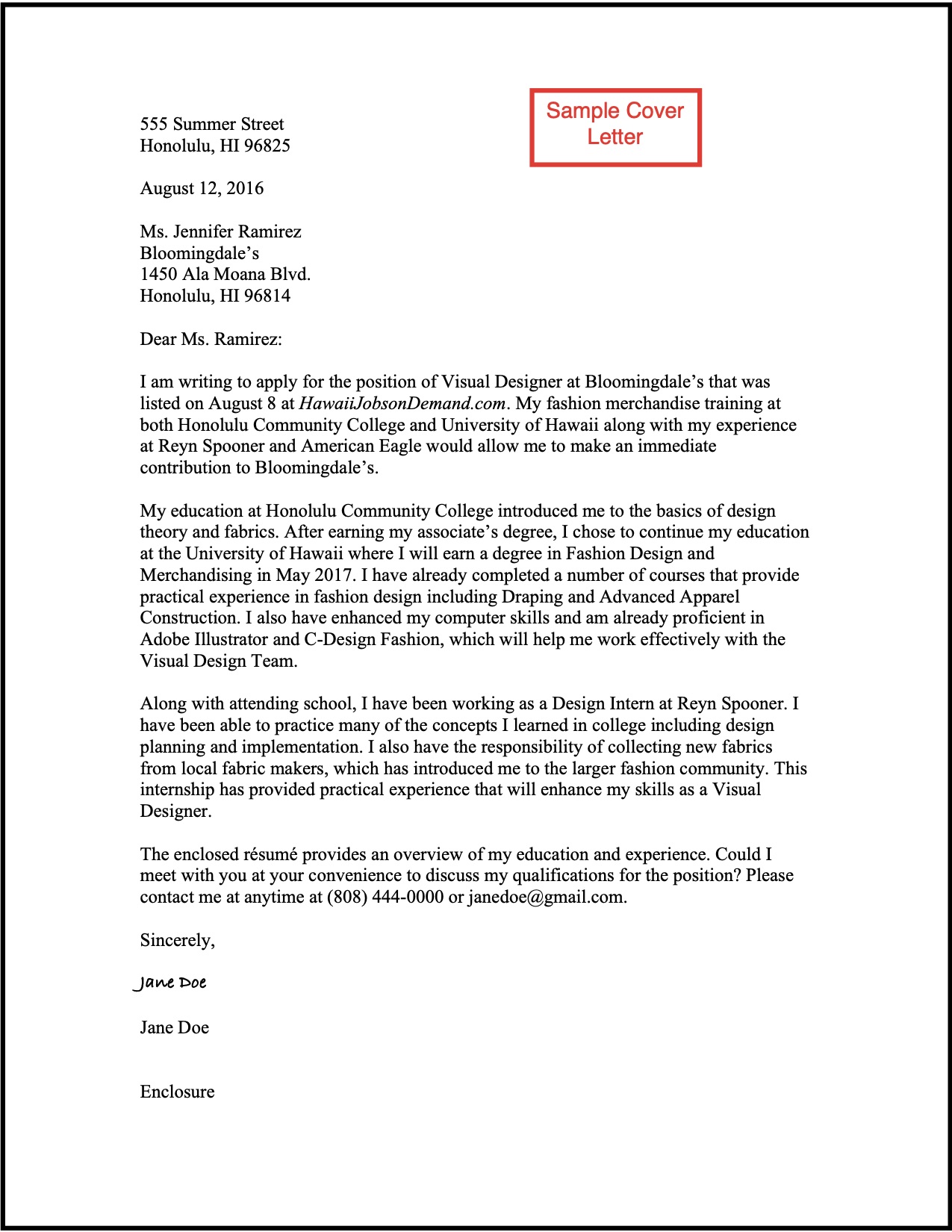
Figure \(\PageIndex{8}\): Sample Cover Letter
Key Takeaway
A résumé will represent your skills, education, and experience in your absence. Businesses increasingly scan résumés into searchable databases. A cover letter will expand on some of what you mention in a résumé.
Exercises
- Find a job announcement with specific duties that represents a job that you will be prepared for upon graduation. Choose a type of résumé and prepare your résumé to submit to the employer as a class assignment. Your instructor may also request a scannable version of your résumé.
- Conduct an online search for a functional or chronological résumé. Please post and share with your classmates.
- Conduct an online search for job advertisements that detail positions you would be interested in, and note the key job duties and position requirements. Please post one example and share with your classmates.
- When is a second page of your résumé justified? Explain.
- Conduct an online search for resources to help you prepare your own résumé. Please post one link and a brief review of the Web site, noting what features you found useful and at least one recommendation for improvement.
References
- Bennett, S. A. (2005). The elements of résumé style: Essential rules and eye-opening advice for writing résumés and cover letters that work. AMACOM.
- Simons, W., & Curtis, R. (2004). The Résumé.com guide to writing unbeatable résumés. New York, NY: McGraw-Hill.

